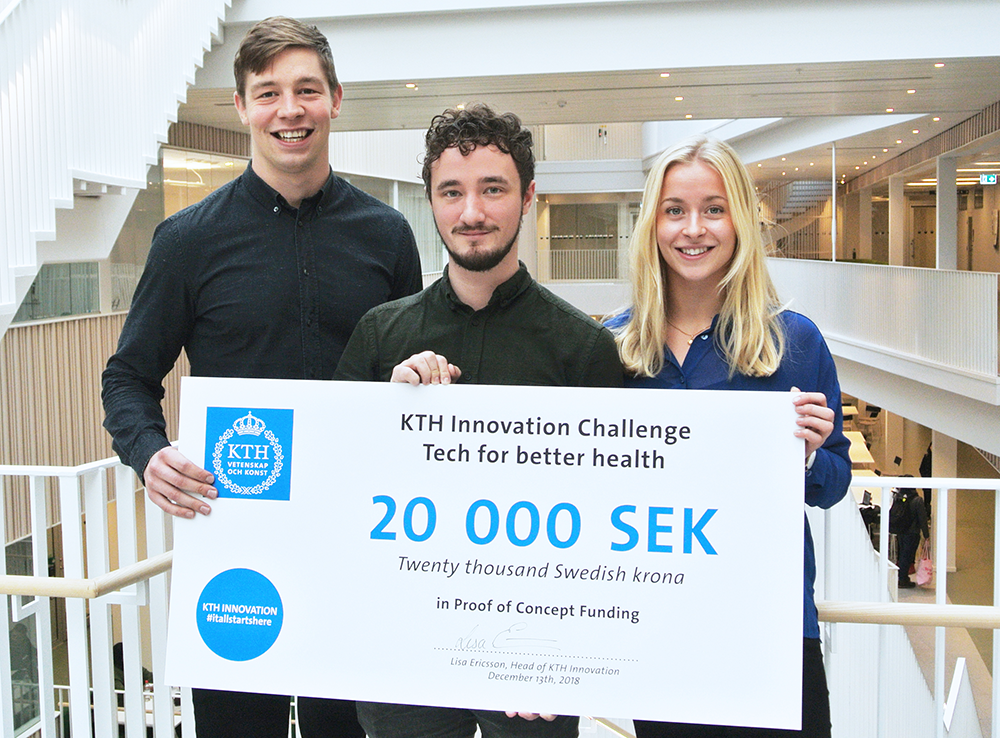Winning angles

A clever way of using advanced technology in a way that can prevent injury and improve athletes' performance was named the winner of our KTH Innovation Challenge Flemingsberg - Tech for better health.
Anyone who’s ever tried their hand at a sport knows how hard it can be to get it right. The angle of your arm, your head’s position, or your shoulders’ height can make all the difference when it comes to hitting the ball just right in tennis, or sticking the landing in gymnastics. But when copying the stars you see on TV seems impossible, and your coach’s feedback doesn’t seem to translate, seeing exactly what you’re doing wrong can really help.
This summer, Facebook released DensePose . Researchers have made a neutral network map our body parts, by letting it study around 50 000 images. In that way, they got a data set of 5 million points that DensePose used to learn what a human body looks like, and how our body parts interact.
KTH students Clara Wessén, Erik Micski and Axel Persson all study at KTH Campus Flemingsberg. They started working with their idea in a course, and in the beginning they didn’t really have plans to keep developing it. Today, they won our KTH Innovation Challenge Flemingsberg: Tech for Better Health.
- We’re a bit shocked that we won, but it feels great, says Erik. The more we’ve worked on our idea, the more we’ve felt that this could really become something. This experience has made us stop looking at this as just another home assignment, and realize that it could actually be worth pursuing.
When Clara, Erik and Axel first heard of DensePose, they immediately started thinking about how they could use it. They came up with an idea to use the network to visualize how sportspeople move, in order to make it easier to give better feedback. When you enter a still image or 2D video into DensePose, the network uses AI to map the contours of the bodies it can detect. The result is a 3D rendering of the body, which is what Clara, Erik and Axel use in their visualization.
Clara, Erik and Axel started by implementing the technology on videos of tennis players, because it was a relatively easy starting point; there’s usually only one or two people in the frame at any single time, you can easily find a lot of material, and a tennis player’s movements are fairly straight and easy to follow.
However, the team sees big opportunities for how the technology can be used in the future, not only in sports, but also in rehabilitation, in biomechanical labs, and so on.
- The possibilities are endless, says Clara.
Right now, the team is busy testing the technology against a motion capture system at GIH, to see how their technology stands against the best there is on the market today. The goal is that the technology, which is to be implemented in an app, will be at least as good as motion capture, with the added benefit of being much easier to access and use. Coaches can use the app to give their students better instructions, and the team is also thinking of letting users compare their own technology to elite athletes’, to make it easier to spot which movements need improvement.
Regarding the support from KTH Innovation, Clara says:
- You can get a lot more support than what we thought, and our coach Gustav was really helpful!
Gustav Notander, the team’s Business Development Coach at KTH Innovation, is in his turn positive about the idea’s future:
- The team has already made good progress, and they’ve confirmed interest from some really interesting people. If they keep working on their idea, it could go a long way!
A total of ten really interesting ideas from both students and researchers based in Flemingsberg entered the challenge, and picking a winner was no easy task. We hope everyone who applied will keep working on their ideas!
Furthermore, if you have an idea you’re thinking of, but haven’t been in contact with us yet, reach out to us today! You don’t need to apply to get our support. All you need to do is to get in touch, and bring your idea and your passion, and we’ll take it from there. Book a meeting here!
